What Is Shade In Art
The Ultimate Guide to Understanding Hue, Tint, Tone and Shade

We frequently hear people say things like, 'What a beautiful blue hue.' or 'What shade of green do you like?' or 'Which t one practise you lot prefer?' or 'That tint is too light.'
Have you ever wondered what exactly they hateful by these color terms? Let me clarify the difference between them. Once yous understand the difference, yous'll never be unsure again. Y'all'll also exist able to describe or mix a color much more hands.
More...
Hue vs Colour
To begin, nearly people use the terms Hue and Color interchangeably. Information technology's very common, even with artists and designers to assume the two mean the same thing.
More often than not speaking they sort of do, simply technically they don't.
The comment above sounds like ane of those mind-bending riddles. In fact, the difference between them is actually very simple.
When you utilize colour in whatsoever project, it'south super helpful to talk or recollect well-nigh each one clearly. So permit me explain the deviation between Hue and Colour in the easiest way possible.
- Color is the general term nosotros utilise to draw every hue, tint, tone or shade we come across. White, Black and Gray are often referred to as a color.
- A HUE refers to the dominant Color Family of the specific color we're looking at. White, Black and Grey are never referred to as a Hue.
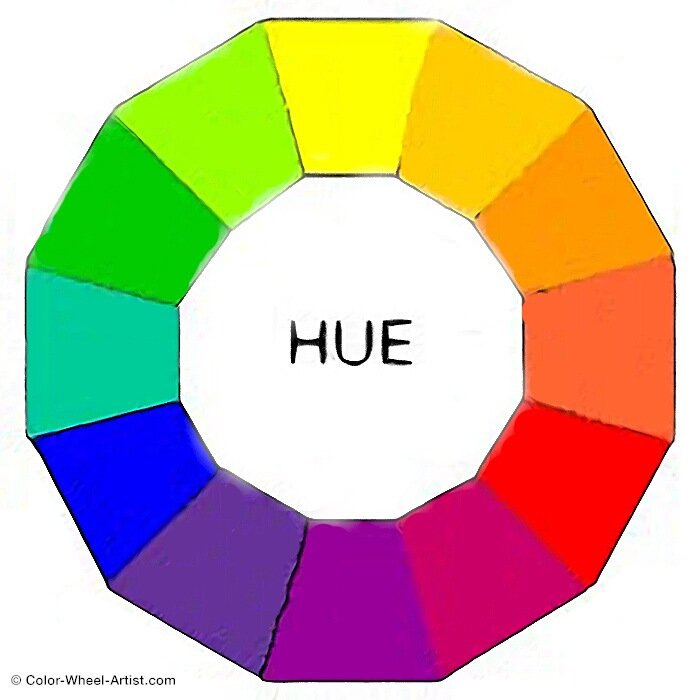
Hue refers to the origin of the color we see. Call back of the Hue as one of the 6 Primary and Secondary colors.In other words, the underlying base color of the mixture you're looking at is either Yellow, Orange, Red, Violet, Blue or Green.
In the photo at the elevation of the page, you obviously know the Hues right away. But what almost more complex colors we want to duplicate in our artwork or projects?
How to Talk Like a Color Pro
What if a color is truly an in-between Tertiary such as a Yellow/Green where neither Yellow nor Green dominate? Obviously you could describe it as a Yellow/Green Hue and you wouldn't be wrong.
Before long you'll detect information technology easy to identify the Hue more than specifically. You'll begin todrill down and impress yourself, by describing the color something similar this:
'The color has a Yellow Hue, leaning strongly toward Green.'
Indeed this clarifies that the mixture began with the Primary Yellow, and gradually added the Secondary color Green.
Neutrals besides incorporate a Hue depending on their originating color. On the other mitt, pure Black, pure White and Pure Grayness do not contain a Hue.
Here are a few examples of how you lot tin expect at a color closely to decide which is the Dominant Hue. One you lot've established this in your mind, it becomes much easier to recreate the color or mix it further.
- Burgundy = RED
- Pink = Ruby-red
- Navy = Blue
- Rust = Orangish
- Cool Grayness = It might be BLUE or even PURPLE or Greenish - Really expect at information technology.
- Warm Brownish = It might be ORANGE but it might be RED or YELLOW - Really await at information technology.
Painting Tips for HUES
* When you desire to mix a specific color, brainstorm by observing it actually closely. Try to come across the Hue Family it originates from. To this end, you will take a clear beginning point to get-go mixing.
* When you buy paint in an art shop, some of the colors will be labeled with the word HUE. Don't be fooled into thinking these are pure Primary or pure Secondary colors. It's a manufacturer misnomer. The 'HUE Colors' are mixed colors that imitate a pure Hue, just never mix well.
Defining and Describing a TINT
A Tint is sometimes also called a Pastel. But to be precise, Colour Theory defines a Truthful Tint as any Hue or mixture of pure colors with just White added.
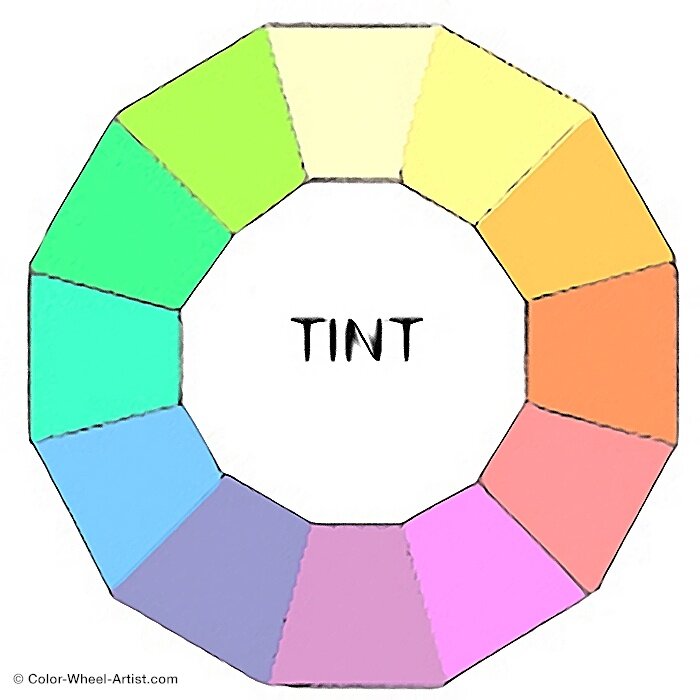
A Tint 50 ightens the color, but it doesn't make it brighter. Even though the color may appear brighter,in actual fact information technologyis not. In other words, it remains exactly the same color, simply a paler version. Furthermore, even a small amount of White added to a color, transforms it into a Tint.
Therefore a Tint can range from slightly lighter than your original color, all the way to White with barely any of the colour mixed in.
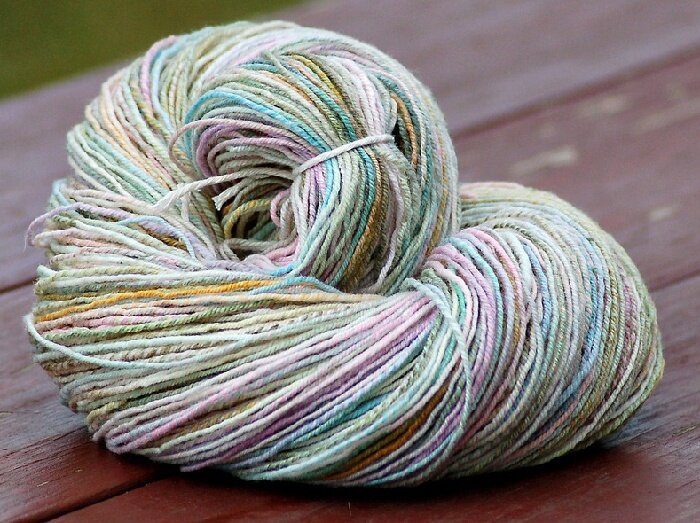
In add-on, a true Tint contains no Grey.
To create a t rue Tint, simply add White toany individual coloron the Color Wheel or any of those pure colors mixed together.
Regardless of this Color Theory definition, artists often bend the rules somewhat. Instead of White to mix a Tint, they utiliseother pale neutral pigments such every bit Titanium or Titan Buff. These paint 'Whites' can produce cute complex Tints.
Painting Tips for TINTS
* To mix pale Tints, ever begin with your White paint. From at that place, very gradually mix in the tiniest specks of your color until you lot achieve the Tint you want.
* Artists frequently add a tiny touch on of White to a pure pigment. This assistance to accentuate the mass tone of the colour making it announced brighter.
* When you lot mix White with any color, be careful and mix extremely gradually. For example, Bright Red can very chop-chop plow into an ugly Pink you don't like.
What Exactly is a TONE?
Color Theory defines a True Tone as any Hue or mixture of pure colors with only Gray added. To be precise, this definition considers Grayness as truly neutral. In other words, there are no boosted pigments in the Gray other than White plus Blackness.
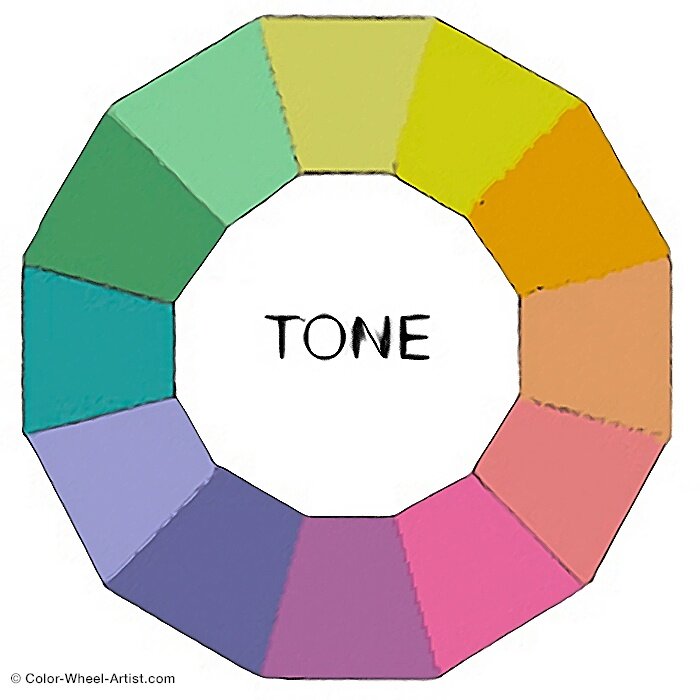
A neutral mixture of Greyness, no matter how calorie-free or nighttime, will tone downwards the intensity of any color. As a general warning, be conscientious with how much Gray you mix in. Too much Gray dulls the color so much, it becomes impossible to get the brilliance dorsum.
Toned colors are generally considered more than pleasing to the eye. They are complex, subtle and sophisticated. That'due south because vivid pure colors are virtually often associated with children.
By and large speaking, about every color nosotros see in our day-to-day earth has been toned to some degree.In the photo below, wait at the colors themselves without thinking of them as wool. Almost every bundle is a slightly Toned version of the original pure colors. Notice how nearly every variation appears to incorporate a fiddlingGray, that is either a light or night Value.
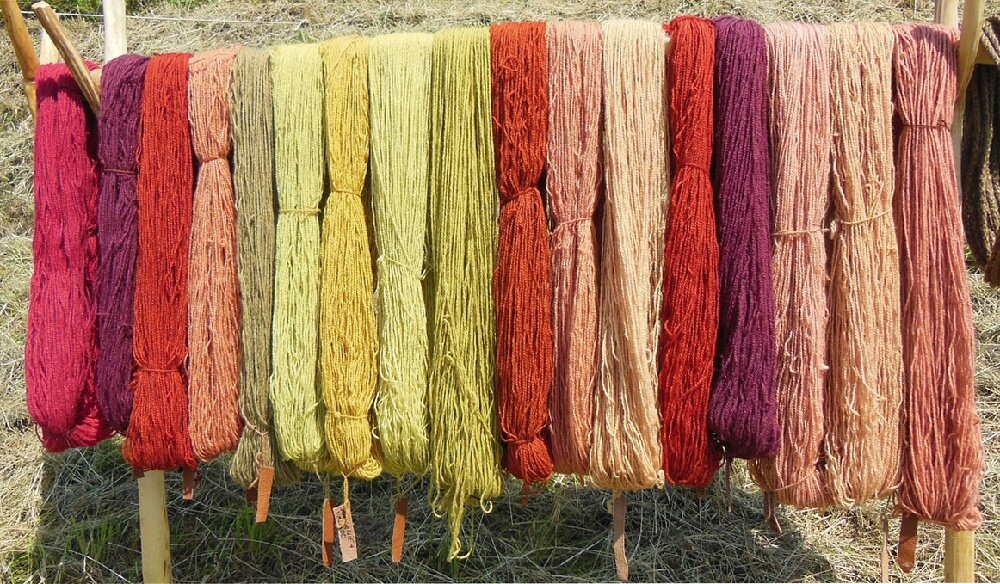
Painting Tips for TONES
* In that location'due south an easy way to mix both lite and nighttime Tones chop-chop while painting. Specifically, pre-mix Low-cal, Medium and Dark Neutral Grays from White plus Blackness. Shop them in small-scale food containers to have them on manus all the time.
* Artist always love to bend the rules. An experienced painter might make a Grey using Paynes Gray plus Titan Buff. It'southward true this will produce a gorgeous Greyness. Only exist extremely careful. Mixtures like this contain Neutral Base Hues such as Bluish or Orange. Therefore, when mixed with other paints, colors tin can become muddy very chop-chop.
* It'due south always a cracking idea to experiment with the color mixtures earlier you pigment. This helps y'all sympathise the potential of each color while avoiding unintended muddy colors in your artwork.
What is the definition of a SHADE?
Color Theory defines a True Shade every bit any pure Hue or mixture of pure colors with only Black added. In other words, it contains absolutely no White or Gray.
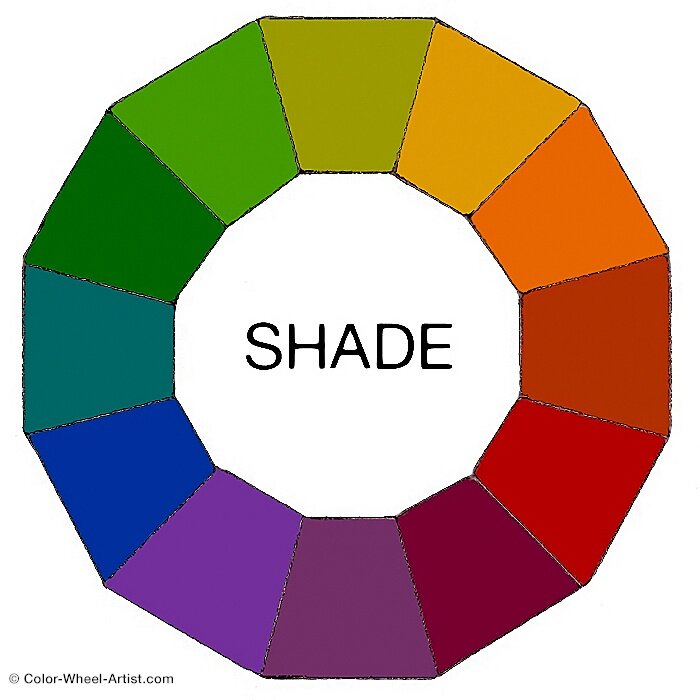
A Shade darkens the color. It remains the same Hue just a darker version. As has been noted above, fifty-fifty a small amount of White or Greyness added to a color, transforms information technology into a Tone.
Therefore a Shade can range from slightly darker than your original color, all the way to near Black with barely any of the color mixed in.
As you tin see below, the colors in the umbrella accept been shaded past the lack of sunlight. Even so, if you wanted to paint this, yous would add a tiny impact of black to each color.
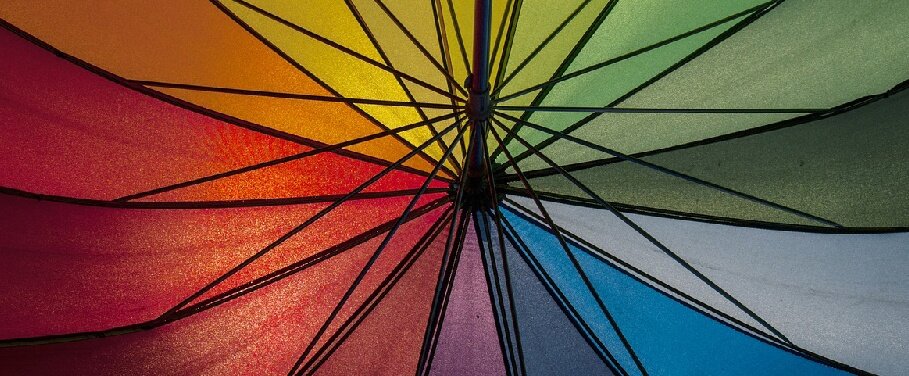
Painting Tips for SHADES
* When you mix a Shade, brainstorm with the color itself. Then add your Black a tiny speck at a time. A petty goes a long manner!
* Over again, many creative person like to bend the rules. Many experienced painters do non use Blackness at all. Instead they create Shade mixtures with Neutral Dark pigments such as Paynes Gray or fifty-fifty Burnt Sienna. These mixtures are gorgeous and complex. However, unless you've pre-tested your pigment mixtures, colors can get dingy very quickly.
Let'south Review What You Learned
- In painting, the word COLOR is the general term for everything nosotros see. Nonetheless, the word HUE refers to the brightest 6 - 12 pure, unmixed pigment families on the Color Bike.
- In Color Theory a TINT whatsoever Hue with White added. The color remains the aforementioned only lighter.
- In Colour Theory, a TONE is any pure Hue with Neutral Gray added. The color remains the same merely less vibrant.The V alues can range from very lite to very dark.
- In Color Theory, a SHADE is any pure Hue with Blackness added. The color remains the aforementioned only darker.
What Is Shade In Art,
Source: https://color-wheel-artist.com/hue/
Posted by: simardritter54.blogspot.com


0 Response to "What Is Shade In Art"
Post a Comment